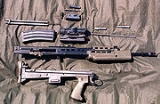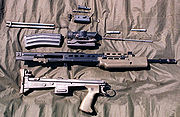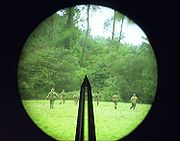
SUSAT
Encyclopedia
The Sight Unit Small Arms, Trilux, or SUSAT, is a 4× telescopic sight
with tritium
-powered illumination, utilised at dusk
or dawn
. The full name of the current model is the SUSAT L9A1. The sight is not designed as a sniper
sight, but is rather intended to be mounted on a variety of rifles and to be used by all infantrymen. A similar device is the Advanced Combat Optical Gunsight
.
 SUSAT is the primary sighting system for the British Army
SUSAT is the primary sighting system for the British Army
's SA80 series weapons
and L108 and L110 light machine guns
. It is also used in the armies of Cameroon
, Oman
, Spain and Sweden
, in assault rifles such as the Swedish Ak5-B
and the Spanish CETME LV
, although after the replacement of the latter by the HK G36, those sights have been employed in Rheinmetall MG3
machine guns.
A similar unit known as the Sight Unit, Infantry, Trilux (SUIT) sight was used on the L1A1 SLR and Sterling 7.62
light machine gun.
 The reticle of the SUSAT is of unusual design. Unlike the traditional crosshair layouts commonly used, which are in essence a cross intersecting the target, the SUSAT has a single obelisk
The reticle of the SUSAT is of unusual design. Unlike the traditional crosshair layouts commonly used, which are in essence a cross intersecting the target, the SUSAT has a single obelisk
-shaped post protruding from the bottom edge of the sight. This type of reticle is sometimes referred to as the "German Post". This obscures the target at long range and the foreground. The reticle is tritium
-illuminated for low-light condition aiming. The radioactive tritium light source has to be replaced every 8–12 years, since it gradually loses its brightness due to radioactive decay
.
, aluminium
body, into which the eyepiece, objective lens
and prisms
are fitted as assemblies.
The SUSAT sight was developed in Great Britain
by Royal Armaments Research Development Establishment (RARDE) and is manufactured by United Scientific Instruments and Avimo, now known as Thales
Optics.
Telescopic sight
A telescopic sight, commonly called a scope, is a sighting device that is based on an optical refracting telescope. They are equipped with some form of graphic image pattern mounted in an optically appropriate position in their optical system to give an accurate aiming point...
with tritium
Tritium
Tritium is a radioactive isotope of hydrogen. The nucleus of tritium contains one proton and two neutrons, whereas the nucleus of protium contains one proton and no neutrons...
-powered illumination, utilised at dusk
Dusk
Dusk is the beginning of darkness in the evening, and occurs after twilight, when the sky generally remains bright and blue. Civil dusk is when the earth has rotated enough that the center of the sun is at 6° below the local horizon...
or dawn
Dawn
Dawn is the time that marks the beginning of the twilight before sunrise. It is recognized by the presence of weak sunlight, while the sun itself is still below the horizon...
. The full name of the current model is the SUSAT L9A1. The sight is not designed as a sniper
Sniper
A sniper is a marksman who shoots targets from concealed positions or distances exceeding the capabilities of regular personnel. Snipers typically have specialized training and distinct high-precision rifles....
sight, but is rather intended to be mounted on a variety of rifles and to be used by all infantrymen. A similar device is the Advanced Combat Optical Gunsight
Advanced Combat Optical Gunsight
Advanced Combat Optical Gunsights are a series of telescopic sights manufactured by Trijicon. The ACOG is designed to be used on the M16 rifle and M4 carbine, but Trijicon has developed ACOG accessories for certain other firearms...
.
Use

British Army
The British Army is the land warfare branch of Her Majesty's Armed Forces in the United Kingdom. It came into being with the unification of the Kingdom of England and Scotland into the Kingdom of Great Britain in 1707. The new British Army incorporated Regiments that had already existed in England...
's SA80 series weapons
SA80
The SA80 is a British family of 5.56mm small arms. It is a selective fire, gas-operated assault rifle. SA80 prototypes were trialled in 1976 and production was completed in 1994....
and L108 and L110 light machine guns
FN Minimi
The Minimi is a Belgian 5.56mm light machine gun developed by Fabrique Nationale in Herstal by Ernest Vervier. First introduced in 1974, it has entered service with the armed forces of over thirty countries...
. It is also used in the armies of Cameroon
Cameroon
Cameroon, officially the Republic of Cameroon , is a country in west Central Africa. It is bordered by Nigeria to the west; Chad to the northeast; the Central African Republic to the east; and Equatorial Guinea, Gabon, and the Republic of the Congo to the south. Cameroon's coastline lies on the...
, Oman
Oman
Oman , officially called the Sultanate of Oman , is an Arab state in southwest Asia on the southeast coast of the Arabian Peninsula. It is bordered by the United Arab Emirates to the northwest, Saudi Arabia to the west, and Yemen to the southwest. The coast is formed by the Arabian Sea on the...
, Spain and Sweden
Swedish Armed Forces
The Swedish Armed Forces is a Swedish Government Agency responsible for the operation of the armed forces of the Realm. The primary task of the agency is to train, organize and to deploy military forces, domestically and abroad, while maintaining the long-term ability to defend the Realm in the...
, in assault rifles such as the Swedish Ak5-B
Ak 5
The Ak 5 is the Swedish version of the FN FNC assault rifle with certain modifications, mostly to adapt the weapon to the Swedish climate. The Ak 5 is the service rifle of the Swedish Armed Forces. Ak 5 is an abbreviation of automatkarbin 5...
and the Spanish CETME LV
CETME Model L
The Model L is a Spanish 5.56mm assault rifle developed in the late 1970s at the state-owned small arms research and development establishment CETME located in Madrid...
, although after the replacement of the latter by the HK G36, those sights have been employed in Rheinmetall MG3
Rheinmetall MG3
The MG3 is a German general-purpose machine gun chambered for the 7.62x51mm NATO cartridge. The weapon's design is derived from the World War II era MG 42 universal machine gun that fired the 7.92x57mm Mauser round....
machine guns.
A similar unit known as the Sight Unit, Infantry, Trilux (SUIT) sight was used on the L1A1 SLR and Sterling 7.62
Sterling 7.62
The Sterling 7.62 was a Battle rifle/Light machine gun variant of the Sterling submachine gun which was manufactured in the 7.62x51mm NATO calibre. It used lever-delayed blowback to handle the more powerful rounds and was fed from 30 round Bren magazines as well as 20 round magazines from L1A1 SLR's...
light machine gun.
Reticle

Obelisk
An obelisk is a tall, four-sided, narrow tapering monument which ends in a pyramid-like shape at the top, and is said to resemble a petrified ray of the sun-disk. A pair of obelisks usually stood in front of a pylon...
-shaped post protruding from the bottom edge of the sight. This type of reticle is sometimes referred to as the "German Post". This obscures the target at long range and the foreground. The reticle is tritium
Tritium
Tritium is a radioactive isotope of hydrogen. The nucleus of tritium contains one proton and two neutrons, whereas the nucleus of protium contains one proton and no neutrons...
-illuminated for low-light condition aiming. The radioactive tritium light source has to be replaced every 8–12 years, since it gradually loses its brightness due to radioactive decay
Radioactive decay
Radioactive decay is the process by which an atomic nucleus of an unstable atom loses energy by emitting ionizing particles . The emission is spontaneous, in that the atom decays without any physical interaction with another particle from outside the atom...
.
Manufacturing
SUSAT is constructed from a one-piece, pressure die-castDie casting
Die casting is a metal casting process that is characterized by forcing molten metal under high pressure into a mold cavity. The mold cavity is created using two hardened tool steel dies which have been machined into shape and work similarly to an injection mold during the process...
, aluminium
Aluminium
Aluminium or aluminum is a silvery white member of the boron group of chemical elements. It has the symbol Al, and its atomic number is 13. It is not soluble in water under normal circumstances....
body, into which the eyepiece, objective lens
Lens (optics)
A lens is an optical device with perfect or approximate axial symmetry which transmits and refracts light, converging or diverging the beam. A simple lens consists of a single optical element...
and prisms
Prism (optics)
In optics, a prism is a transparent optical element with flat, polished surfaces that refract light. The exact angles between the surfaces depend on the application. The traditional geometrical shape is that of a triangular prism with a triangular base and rectangular sides, and in colloquial use...
are fitted as assemblies.
The SUSAT sight was developed in Great Britain
Great Britain
Great Britain or Britain is an island situated to the northwest of Continental Europe. It is the ninth largest island in the world, and the largest European island, as well as the largest of the British Isles...
by Royal Armaments Research Development Establishment (RARDE) and is manufactured by United Scientific Instruments and Avimo, now known as Thales
Thales Group
The Thales Group is a French electronics company delivering information systems and services for the aerospace, defense, transportation and security markets...
Optics.
Specifications
SUSAT L9A1- Length: 145 mm
- Height: 55 mm
- Width: 60 mm
- Weight: 417 gram
- Magnification: 4×
- Entry eyepiece: 25,5 mm
- Exit eyepiece: 6,0 mm
- Field of vision: 10 degrees
- Eye distance: 25 mm
- Light permeability: >80%
- Illumination: Red tritium, glass ampoule
- Illumination strength: Adjustable
- Tritium ampoule lifetime: 8–12 years
- Focus: −0.75 to −1.25 dioptreDioptreA dioptre, or diopter, is a unit of measurement of the optical power of a lens or curved mirror, which is equal to the reciprocal of the focal length measured in metres . It is thus a unit of reciprocal length. For example, a 3-dioptre lens brings parallel rays of light to focus at metre...
s - Operational temperature: −46 to +71 °CCelsiusCelsius is a scale and unit of measurement for temperature. It is named after the Swedish astronomer Anders Celsius , who developed a similar temperature scale two years before his death...
External links
- United Scientific Instruments - Official website
- Image of Trilux SUIT
- Similar view of SUSAT sight

